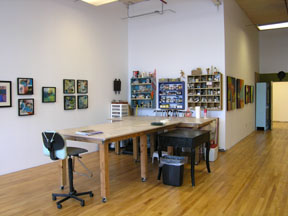Bourgeois was still working at the age of 98
Tracey Emin spoke to Radio 4's PM about artist Louise Bourgeois, who has died at the age of 98.
Emin, who had recently collaborated with Bourgeois, explained what it was like to work with her, why the art world was in mourning, and her lasting legacy for female artists.
Quoting Emin:
I first became aware of her work in the mid-1990s. Stuart Morgan had curated an exhibition at Tate Britain and Louise Bourgeois was in this exhibition. I was under the impression that she was this young American wild girl, so I was delighted to find out that she was in her 80s and had been in it for 45-50 years.
It was an inspiration that a woman could have that longevity and still be making really exciting and appealing work which still looked really young, and youthful. It didn't look like something from the past. It looked like something from here and now.
The thing I really loved about Louise Bourgeois was that she wasn't afraid of her emotions; she wasn't afraid of being totally female and releasing those kind of emotions into the world through her art as a lot of men have done through history - whether it's Van Gogh, whether it's Edvard Munch with his jealousy, whether it is Picasso about love. Woman are actually much better at this kind of thing than men, and Bourgeois wasn't the Queen of this, she was the King.
'Deeply privileged'
I had been working with Louise on a collaboration for the last two years. It was a symbiotic thing. Because we both work with our hearts and what actually drives us emotionally, we connected very, very well and I have felt deeply privileged to have been able to work with her. So she's not really an influence, more of a kindred spirit.
Louise made a series of watercolours, which she then made into prints, which she sent to me and I had to work on top of them. It took me months and months and months and months to do it, and Louise kept saying to me "don't worry - there is lots of time". I eventually finished them a few months ago. When you see them as a series you can't tell they have been made by two different artists, they look like they have been made by one artist.
I first became aware of her work in the mid-1990s. Stuart Morgan had curated an exhibition at Tate Britain and Louise Bourgeois was in this exhibition. I was under the impression that she was this young American wild girl, so I was delighted to find out that she was in her 80s and had been in it for 45-50 years.
It was an inspiration that a woman could have that longevity and still be making really exciting and appealing work which still looked really young, and youthful. It didn't look like something from the past. It looked like something from here and now.
The thing I really loved about Louise Bourgeois was that she wasn't afraid of her emotions; she wasn't afraid of being totally female and releasing those kind of emotions into the world through her art as a lot of men have done through history - whether it's Van Gogh, whether it's Edvard Munch with his jealousy, whether it is Picasso about love. Woman are actually much better at this kind of thing than men, and Bourgeois wasn't the Queen of this, she was the King.
'Deeply privileged'
I had been working with Louise on a collaboration for the last two years. It was a symbiotic thing. Because we both work with our hearts and what actually drives us emotionally, we connected very, very well and I have felt deeply privileged to have been able to work with her. So she's not really an influence, more of a kindred spirit.
Louise made a series of watercolours, which she then made into prints, which she sent to me and I had to work on top of them. It took me months and months and months and months to do it, and Louise kept saying to me "don't worry - there is lots of time". I eventually finished them a few months ago. When you see them as a series you can't tell they have been made by two different artists, they look like they have been made by one artist.
Emin described Bourgeois as a 'kindred spirit'
Louise was formidable. The first time I met her, she shouted at me. She asked me how many times I had been to New York and, when I told her, she said in French 'why haven't you ever come to see me before?' which I took to mean she didn't like me, but actually she was giving me a major compliment.
Role model
The last time I saw her, I gave her a flower and she just spoke French to me the whole time and she was very sweet and incredibly interesting. The last hour we spent together we looked through a book of Jung's art and images and talked about birth and life.
Right until the very end, she was completely together and amazing and still working, which was fantastic - 98 and still making art. If that isn't a really good role model for female artists then I don't know what is.
She never lost sight of what she was, which was an artist and a really fantastic artist. She was so amazing and so important - and this is why the world had paid heed to her death.
When Picasso died everyone fainted, now Louise Bourgeois has died and everyone is crying. It is a really sad moment for art, but a really fantastic moment for female artists because at last we have someone who is up there with the greats.










1 comment:
Lovely and an inspiration, thanks for posting.
Post a Comment